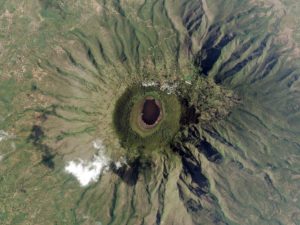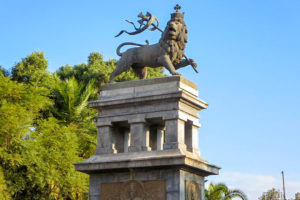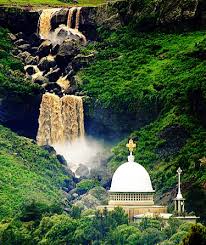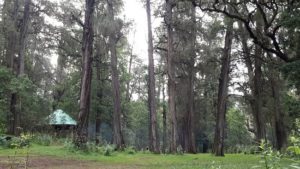
Exhibits numerous relics and archeological findings from prehistoric times to modern day, The skeleton of the early hominid “Lucy” which is 3.5 million years old and the fossil Ramadis – Ramadis Kabala. (5.8 million years old) are very historic.
Contact Us & Book Your Tour Now
 It was part of the late Emperor Haileselassie’s former palace. It now houses an interesting overview of Ethiopian crafts, culture and art. The art section contains an extensive collection of well displayed classical, religious, icons and artifacts as well as more recent paintings.
It was part of the late Emperor Haileselassie’s former palace. It now houses an interesting overview of Ethiopian crafts, culture and art. The art section contains an extensive collection of well displayed classical, religious, icons and artifacts as well as more recent paintings.
Contact Us & Book Your Tour Now
 45 kms from Addis Ababa, Debrezit with a fine weather is a resort area. Lakes like Bishoftu, Hora, Chelelaka, green crater, offer an outstanding bird life like pelicans, flamingos, storks, grebes king fishers etc.
45 kms from Addis Ababa, Debrezit with a fine weather is a resort area. Lakes like Bishoftu, Hora, Chelelaka, green crater, offer an outstanding bird life like pelicans, flamingos, storks, grebes king fishers etc.
Mount Zuquala, 4th century site, is an extinct volcanic cone about 600 mts high. From the top you can see the Rift Valley & the Crater lakes. The monastery of Gebremenfeskidus attracts many pilgrims. It is also a spot for short trekking
Contact Us & Book Your Tour Now
MENAGESHA – SUBA STATE FOREST
EMP – 401, TREKKING ROUTES
The Oldest Park In Africa
Menagesha – Suba State Dorest could be called the “oldest Park in Africa”. The Emperor Zera Yakob (1434 – 1468) designated the forest as one of the crown forest of the country. So that the oldest trees in Menagesha – Suba are over 500 years old.
The fist Ethiopian National Forest Policy was developed by Emperor Menelik II in the late 1890’s. He set aside State Forest Reserves, including the menagesha – Suba forest. Guards were assigned to protect the forest and boundaries were demarcated.
The fist Ethiopian sawmills was installed in the forest around 1900. The machinery was installed by Otto, a German – Australian entrepreneur, and that part of the forest is still called “Otto”. During the Italian occupation (1936 – 1942) a small railway was built in the forest to extract logs to the sawmill and it was in use till 1955.
The first modern tree nursery for the country was set up by 1949 in Suba, and eight Hectares of land were planted with both exotic and indigenous species between Suba village and the forest head quarters.
ENDEMIC BIRDS AND MAMMALS
A survey in 2001 found that 32 species of mammals and 186 species of birds in Menagesha – Suba State Forest.
Two of the mammals, Menilik’s Bush-Buck and White-footed Rat are endemic. The four endemic birds recorded in the forest are Abyssinian Catbird, Abyssinian Woodpecker, Black-Headed Siskin, and Yellow Fronted Parrot.
THE FOREST WALKING TRAILS
The following walking trails have been marked out to help the visitors explore the forest. Each trail takes walkers through different aspects of the forest. The trails are also different lengths and difficulty so that visitors can choose according to their time and strength. The trails are numbered on the map and marked with colored sign boards in the forest.
- MAIN TRAIL (5KM) 1:30 to 2:00 hours walking.
This trail takes the visitor from the state forest office and training center up to the Exhibition Center above the forest. It can be driven by 4WD vehicles, and walkers are advised to keep well away from the passing vehicles as it can slide into the side of the road when the road is wet. In fact visitors are strongly advised not to drive on this trail when it is raining.
The trail is a challenging walk, starting at 2210m at the office and going to 2900m at the exhibition center. The trail ascends gently at first through old and more recently planted junipers. Then a bridge crosses a steep valley, just above it is the campsite and picnic area where permanent spring pours into an old open thank. A short distance from the campsite the road forks – take the right hand track to the top of the forest.
The road above this is much steeper, near the top of the forest where the trees are smaller, walkers can rest and admire the view from the viewpoint.
The road then gets gentler and the trail goes through ASTA all the way to the Exhibition Center, where a magnificent over the Becho plains can be enjoyed.
2 – TONA ROAD (5KM) 1:00 to 1:30 hours walking
This trail circles the valley to the south of the SFO. The map only shows the general direction of the trail, which in fact twists and turns providing opportunities for surprising wildlife, particularly Menilik’s Bush-Buck. The trail starts from the SFO and ends in Suba village where the visitor can see where the old sawmill and the large tree nursery area.
The old railway line below the office the office to sawmill can also be walked to reach Suba village quickly, the railway line is only 1.7 Km long.
3 – THE BIG TREE TRAIL (1.5KM) 0:20 to 0:30 hours walking
The trail takes visitors along the side of the valley to the north of the SFO and joins the main track near the entrance to the forest. The name of this trail comes from the biggest trees found in the forest. It is juniper tree with a trunk 8.6 m in circumference. Visitors also walk between the natural forest and some of the plantation species.
The Big Tree Trail can be combined with the Tree Species Trail that takes visitors through the area near the SFO. This area has 14 tree species in it, all of which are marked with information boards.
4 – WATERFALL TRAIL (8KM) 2:30 to 3:00 hours walking
This trail is most impressive after the rainy season in October, but there is water in the river all year round. The Otto sawmill was originally placed in this part of the forest and then moved by the Italians to Suba Village in the 1930’s.
The waterfall trail starts from the left hand fork where the track divides above the campsite on the Main Trail. The trail takes walkers through the part of the forest that was heavily exploited in the early 1900’s Fekade Tuta’s stone marks the place where a forest guard was killed in a thunderstorm in 1991.
5 – DHAMOCHA PEAK TRIAL (5KM) 2:00 to 3:00 hours walking
The Dhamocha Trial takes visitors from the exhibition center through the farmland in the crater to the Peak of Wechecha Mountain at 3385 m. The walk is steep and hard, but the reward is fantastic panoramic view of the surrounding area, including Addis Ababa.
Majestic Tour Operators is the only place where you are guaranteed for economical and convenient tour package as well as the most reliable and comfortable services.
Thank you for choosing Our Company
Contact Us & Book Your Tour Now


 It was part of the late Emperor Haileselassie’s former palace. It now houses an interesting overview of Ethiopian crafts, culture and art. The art section contains an extensive collection of well displayed classical, religious, icons and artifacts as well as more recent paintings.
It was part of the late Emperor Haileselassie’s former palace. It now houses an interesting overview of Ethiopian crafts, culture and art. The art section contains an extensive collection of well displayed classical, religious, icons and artifacts as well as more recent paintings. It provides a panoramic view of Addis Ababa, Entoto Mariam church, the museum & St. Raguel’s church, are all of great historical values.
It provides a panoramic view of Addis Ababa, Entoto Mariam church, the museum & St. Raguel’s church, are all of great historical values. It is the best cathedral in Addis Ababa. It is also the burial ground of the late Emperor Haileselassie.
It is the best cathedral in Addis Ababa. It is also the burial ground of the late Emperor Haileselassie. The capital city Addis Ababa, is a host city of many international organizations like UNECA (United Nations Economic Commission for Africa), OAU (Organization of African Unity) now A.U (African Unity) etc.
The capital city Addis Ababa, is a host city of many international organizations like UNECA (United Nations Economic Commission for Africa), OAU (Organization of African Unity) now A.U (African Unity) etc. Two million years old archeological site is found at melkakunture (52 km for Addis Ababa). 13th Century rock hewn Church of AdadiMariam and 12th Century A.D. steles at Tiya (World Heritage Site by UNESCO), are very interesting
Two million years old archeological site is found at melkakunture (52 km for Addis Ababa). 13th Century rock hewn Church of AdadiMariam and 12th Century A.D. steles at Tiya (World Heritage Site by UNESCO), are very interesting Ethiopia
Ethiopia 45 kms from Addis Ababa, Debrezit with a fine weather is a resort area. Lakes like Bishoftu, Hora, Chelelaka, green crater, offer an outstanding bird life like pelicans, flamingos, storks, grebes king fishers etc.
45 kms from Addis Ababa, Debrezit with a fine weather is a resort area. Lakes like Bishoftu, Hora, Chelelaka, green crater, offer an outstanding bird life like pelicans, flamingos, storks, grebes king fishers etc. Indigenous birds such as Cormorants, Blue Headed Siskin and the Rouget’s Rait are among the bird life which can be seen here. The Managesha forest covered with Juniper trees as old as 400 years can offer a nice walk.
Indigenous birds such as Cormorants, Blue Headed Siskin and the Rouget’s Rait are among the bird life which can be seen here. The Managesha forest covered with Juniper trees as old as 400 years can offer a nice walk.